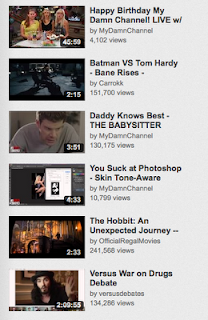YouTube Now: Why We Focus on Watch Time
This is the first of a series called “YouTube Now,” which we’ll use to explain how we’re evolving the site, and why.
Would you like to suggest a topic of interest to creators for a future YouTube Now? Please drop it in the comments below.
Today’s topic: why we surface videos that drive watch time.
YouTube viewers watch a lot of video -- over 4 billion hours a month at last count. But the average household also watches several hours of video per day on their TVs. So for YouTube to become the most important media in more people's lives, we've got a lot of growing to do.
Over the past few months we have made some changes to YouTube to encourage people to spend more time watching, interacting, and sharing with the community.
To support this, we’ve updated what we call video discovery features, meaning how our viewers find videos to watch via search and suggested videos. These changes better surface the videos that viewers actually watch, over those that they click on and then abandon.
Why this shift? Our video discovery features were previously designed to drive views. This rewarded videos that were successful at attracting clicks, rather than the videos that actually kept viewers engaged. (Cleavage thumbnails, anyone?)
Now when we suggest videos, we focus on those that increase the amount of time that the viewer will spend watching videos on YouTube, not only on the next view, but also successive views thereafter.
If viewers are watching more YouTube, it signals to us that they’re happier with the content they’ve found. It means that creators are attracting more engaged audiences. It also opens up more opportunities to generate revenue for our partners.
These changes have so far proved very positive -- primarily less clicking, more watching. We saw the amount of time viewers spend watching videos across the site increase immediately, and this positive trend has continued as we’ve made additional tweaks to our suggestions. Improvements in the stats we measure, such as average view duration, provide a solid indication that the videos we are recommending throughout the site are even more engaging.
How can creators thrive in this new world?
The best thing creators can do to be successful on YouTube is make videos that people want to watch. Simple, isn’t it? Unfortunately, many of the tactics we’ve heard from creators to optimize for YouTube’s discovery features may in fact backfire.
For example, we’ve heard from some creators who intentionally made their videos shorter in an attempt to get a higher retention rate. Unfortunately, this won’t help. While high retention on your videos is a good indication of engagement, we are actually optimizing for how a video contributes to a longer viewing session on YouTube. So your video isn’t more likely to be seen just because it’s shorter.
Conversely, we’ve also heard from some creators who intentionally made their videos longer, assuming that longer videos lead to more watch time. This also isn’t necessarily true, because it can be more challenging to keep viewers engaged through a longer video. (Think of a comedy sketch that drags on... just... a little... too long.)
As a result, our primary recommendation is to simply continue making the great videos your audience loves, and stay away from questionable optimization strategies.
Watch your data
And here’s how we’re about to make this easier for you: In the next few weeks we will provide enhanced watch time information in YouTube Analytics. In sum, we aim to give you as much information about watch time as we do about views today.You'll start to see this in YouTube Analytics in the next few weeks.
In the meantime, we currently offer a downloadable report available with time watched data. You can use this data to better understand what your audience wants to watch. More time watching your content means a more engaged audience and more revenue for you. That’s what our focus on watch time is all about.
